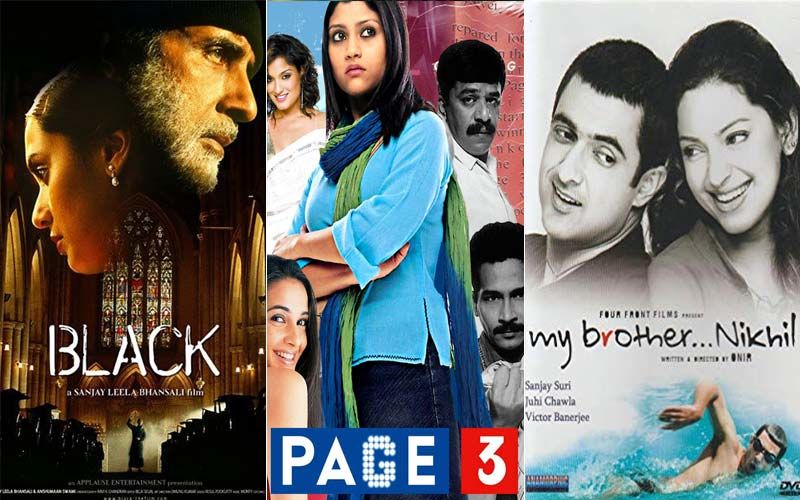Black, Page 3 And My Brother Nikhil; 3 Intense Films For Lockdown Viewing - PART 6
Continuing with our series of lockdown entertainment, we tell you why you must watch Black, Page 3 and My Brother Nikhil.

The latest additions to our lockdown entertainers are Amitabh Bachchan - Rani Mukerji starrer Black, Konkana Sen Sharma fronted and Madhur Bhandarkar directed Page 3 and Juhi Chawla - Sanjay Suri starrer My Brother...Nikhil. Read to know why these three gems can turn out to be a perfect watch for you.
Black (2005): Veering passionately away from the norm, creating an entirely new definition of entertainment and giving us a work of art that transcends every given qualification of the motion-picture experience Sanjay Leela Bhansali created a work that freezes all superlatives and permanently relocates our perceptions of high-quality, intellectually and emotionally stimulating art. From the opening when the blind-and-deaf Michelle(Rani Mukherjee) runs into her old blind and dying teacher Debraj (Amitabh Bachchan), Black clamps its emotional tentacles around our heart and refuses to release us until its last dying breath exhales on-screen, permeating the film’s fragrant and irradiant aura with fumes that we have never smelt before.
Black unleashes a fury of never-felt emotions. Watching the actors at work we feel them undergoing the kind of emotional flagellation actors seldom do. Our responses too touch feelings in our heart that are too deep for tears and yet too precious to be hidden away. Master-creator that he is, Bhansali peels away layers and layers of passionate pain. The characters stand stark-naked on camera their souls exposed for us to see. We can’t turn away. Bhansali doesn’t give us that choice. It takes a while to come to terms with the awesome and overpowering emotions of Bhansali’s world. Getting a fix on Michelle’s world isn’t easy. What is this twilight zone of resplendent suffering where every hurt is felt like whiplash? Indeed the quality of cinematography by Ravi Chandran and the background music by Monty is so steeped in the ethos of anxious yearnings, we feel the characters’ hearts are forever on the verge of bursting open.
The film has some such effect on us as well. Never before has a filmmaker created such a frenzied and anxious world of looming longings where every gesture of self-negation is also a renewal of the life-cycle. We first enter little Michelle’s pitch-black world with Debraj. The relationship that grows between the impossibly difficult little girl (debutante Ayesha Kapoor, playing Rani’s childhood portions ) and the equally difficult teacher is underscored by an immense and acute irony. As Debraj makes Michelle ‘see’ into the light through her blindness, he goes blind and finally loses his mind. In the best most heart-wrenching moments of the film, Michelle rattles the chains that are put on her guru to prevent him from causing himself bodily harm. That frenzied chain-rattling becomes symbolic of everything that Bhansali’s incredibly grand cinema attempts to do. The darkest most inexpressible thoughts acquire shape in Bhansali’s tortured and yet incredibly beautiful realm of self-expression. Credit for giving shape to his vision goes in no small measure to Bhansali’s technicians who miraculously, find just the right voice for the director’s anguished feelings.
My Brother Nikhil (2005): An intimate and yet far-reaching study of family ties, social castigation and the resilience that makes the human spirit ride over daunting adversities—much like the swimmer- hero of debutant director Onir’s heartwarming film who rides the oceans …until oceanic events overtake his well-ordered life. My Brother…Nikhil is a film about a very critical social cause, AIDS to be precise….The imprecise parameters of the complex issue are framed in a quaint but never over-emphasized or excessively well-ordered pyramid of montages. The narrative moves to a contrary beat whereby sections of the heart-rending story open up to us almost like the petals of a reluctant flower that must blossom before it’s too late.
Like many of the new avant-garde directors, Onir uses the Brechtian distancing device whereby the characters speak directly into the camera about the protagonist. We get to ‘know’ Nikhil (Sanjay Suri), the bright promising sportsperson whose career life and self-regard are shattered by tragedy, through the voices of his father Navin Kapoor (Victor Bannerjee), mom Anita (Lillete Dubey), friend and companion Nigel (Purab Kohli) and sister Anu (Juhi Chawla). The multiplicity of voices never crowd the narrative. Could it be because the narrative favours stillness over shrillness? There are great moments of drama in the narrative, especially towards the end when the dying hero has to come to terms with his impending end. Scenes between Nikhil and his loved ones will rip your heart open with their translucent candour. (I get tearful even as I write about those moments).
Onir never milks the inherent tragedy of the theme for melodrama. As in the masterful Black, the emphasis in My Brother…Nikhil is on light rather than dark. The ocean-blue landscape quietly captured by Arvind Kannabiran’s non-judgemental camera weaves through these flawed lives like a stream winding its way through a craggy valley Not since Shyam Benegal’s Trikal have characters looked so much at home in Goa. As we peer into Nikhil’s cosy world we, the spectators, are never made to feel like intruders but rather, like welcome guests. The absence of mawkishness in the drama is a constant reminder of the new levels of maturity being attained by our cinema. Less always seems more in My Brother…Nikhil. And that’s part of its innate charm as a story and a slice of life that cuts a deep dent into our hearts without using a sharp knife There are no sharp edges in the narrative, no laboured attempts to get our attention, even in moments of heart-rending tragedy.
Page 3 (2005): Often in the course of this mordant view of a decadent elitism, you don’t know whether to laugh or cry. Or just feel sorry for people who abuse little children for pleasure. ….And Lata Mangeshkar’s pain-lashed voice comes on the exceptionally evocative soundtrack singing Kitne ajeeb rishtey hain yahan par…. It’s that rare time in a cineaste’s life when he needs to sit up and shake himself awake from the semi-slumber of watching the same old formulas wrapped up in shiny cellophane. Madhur Bhandarkar—God bless his troubled conscience!—peels off the layers of subterfuge and artifice that have become a huge part of our lives, both in and out of the movie theatres, to expose the festering wounds of a world that whips itself into shapes of sickening self-gratification.
Welcome to the beau monde where everything is for sale, especially the conscience…where the rich and famous blow kisses in the air. As the humid room records their passionate pretences, the emptiness of their ecstasy is exposed in recriminating rings of ricocheting realism. These are people whom you’re bound to run into at your next party at the most happening place in Mumbai. The noise, the smoke, the blaring music, the boasting and bitching….yup, Bhandarkar knows this world like the back of his hand. He cannibalizes characters who colonize these catty congregations to put together a story that grips you by your guts….and refuses to let go.
This isn’t the first film to mourn the death of the conscience in a competitive world. What makes Page 3 so deliciously decisive and many pegs (hic!) above other films and plays ripping away the satiny sheets of hypocrisy in the beau monde, is the skilled words and visuals that contextualize saturated people while remaining detached from their depraved and subverted definitions of a full and happy life. Bhandarkar fills the screen with a conflicting college of smug thrill-seeking characters. They’re either wannabes or have-been-there-done-it-all types. The world of ambition and disappointment, agony and ecstasy comes together in a stunning clasp of resplendent exploration of a decadent lifestyle.
It’s easy to attribute the film’s inner strength to the hugely gifted ensemble cast and the emotionally equipped soundtrack. But above all of these, Page 3 tells a truly riveting story conveying cyclonic changes in the graph of morality as the characters move from one state of yearning to another, kicking off their high heels to plunge into the low life. Bhandarkar who made the unforgettable Chandni Bar three years prior has been doddering on the brink with his two misfires Satta and Aan: Men At Work. By depicting the redemptive journey of one journalist Madhavi (Konkona Sen Sharma) who goes from phoney page-3 reporting to straight-from-the –morgue crime reportage, Bhandarkar redeems his own compromised creativity. Whereas Chandni Bar was to a large extent redeemed by Tabu’s plot-defining performance the acting talent on Page 3 is scattered uniformly to subsume a wealth of walloping emotions.
From the boastful driver bragging about his mater’s exploits to the drivers outside the party to the party animals ranging from the social-climber to the nymphomaniac, to the cocaine-snorting children of the rich and the blasphemous…..the film takes a tightly telescopic view. The editing ( Suresh Pai) and the cinematography (Madhu Rao) harmonize the film’s superbly -filled view of existential emptiness by focusing on the entire personality of the characters rather than just their overt gestures. The actors are almost uniformly first-rate, with Boman Irani as the fair-but-finally-scared newspaper editor, Sandhya Mridul as a spunky air hostess (who marries ‘old’ money), Rehan Engineer as a gay dress designer, Bikram Saluja as a picture-perfect superstar who uses people without meaning to offend them, and the Bhandarkar regular Atul Kulkarni as the conscientious crime reporter, taking the lead and leading the takes to heights of expressionism. A special word for Konkona Sen Sharma. How does she manage to pick projects with a relatively long shelf life? Page 3 is a glorious Hindi beginning for this eminently mouldable actress. She uses her personal emotional and physical sensitivities to make her journalist’s character crisply credible. Seldom in recent years has an ensemble cast made such articulate space for itself in the narrative.
The biting dialogues and the simmering sarcasm of people on the edge spice up Bhandarkar’s emphatic narrative without putting too fine a point to the message about the hypocrisy of the hollow people. The characters are never condemned but depicted savagely nonetheless as casualties of the glamorous world that they think they possess and rule. It’s that sense of phoney splendour that emerges from the narrative to hit us straight in the solar plexus. Bhandarkar had made the same impact earlier with Chandni Bar. Here he seems to be much more in control of his craft and the commodious collection of characters who often move in and out of camera range without slipping away from our attention. You really can’t ignore these fatally flawed people. …Or the return of Madhur Bhandarkar. Page 3 is a fine hard-hitting and often jolting film with a climactic corkscrew twist that would shock only those who think the world of illusions, also known as showbiz, is exempted from the harsh reality of disintegrating values and complete erosion of self-questioning morality.
Image Source: IMDb,aazon,bumppy, youtube/sanjaysuriofficial/latamangeshkar_hd/amitava1998
Image Source: IMDb,aazon,bumppy, youtube/sanjaysuriofficial/latamangeshkar_hd/amitava1998


_2024-12-18-6-32-38_thumbnail_2025-12-15-14-32-49_small.jpg)